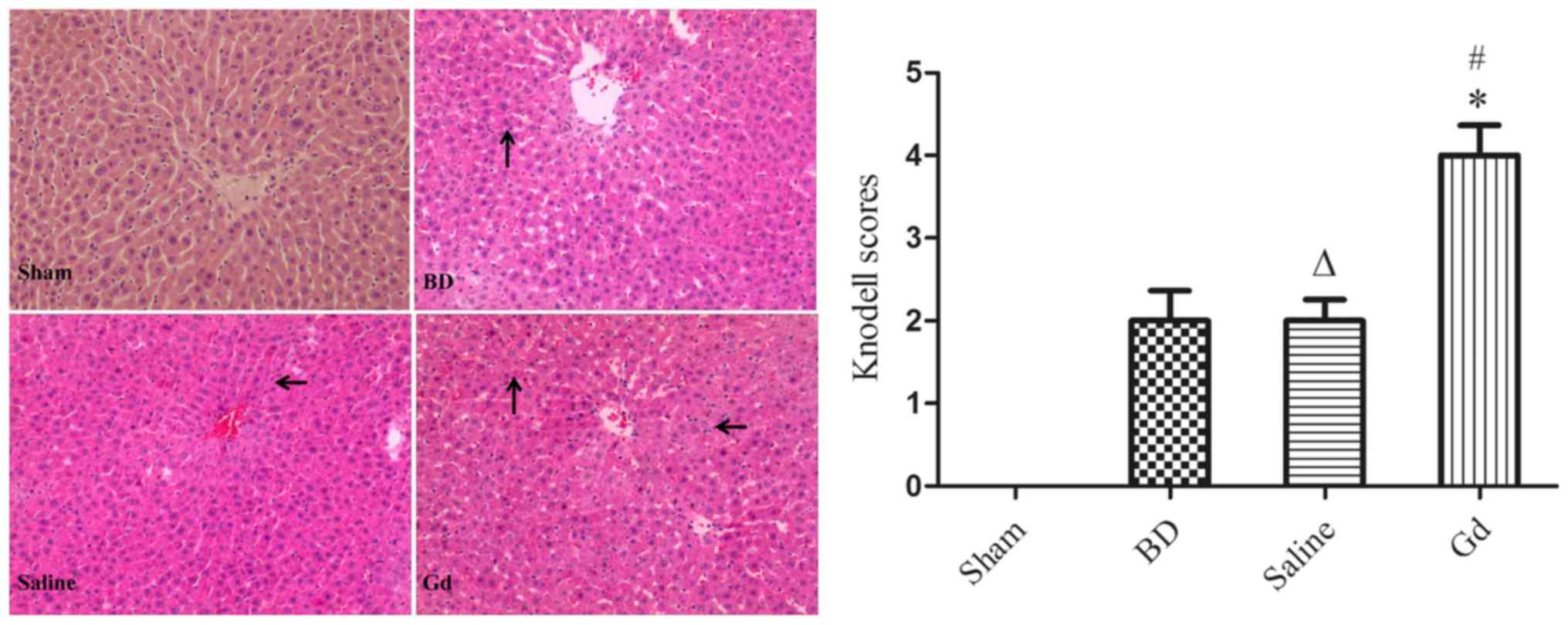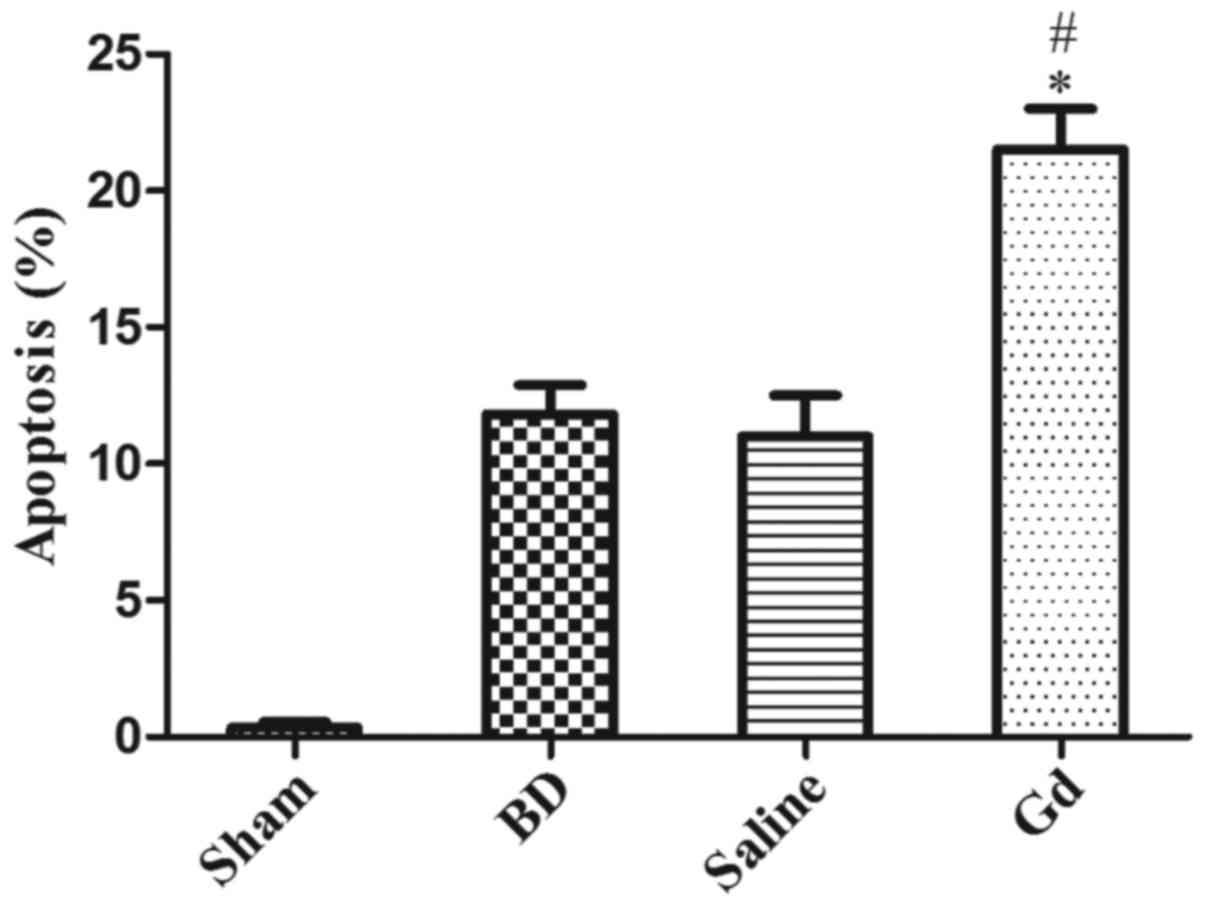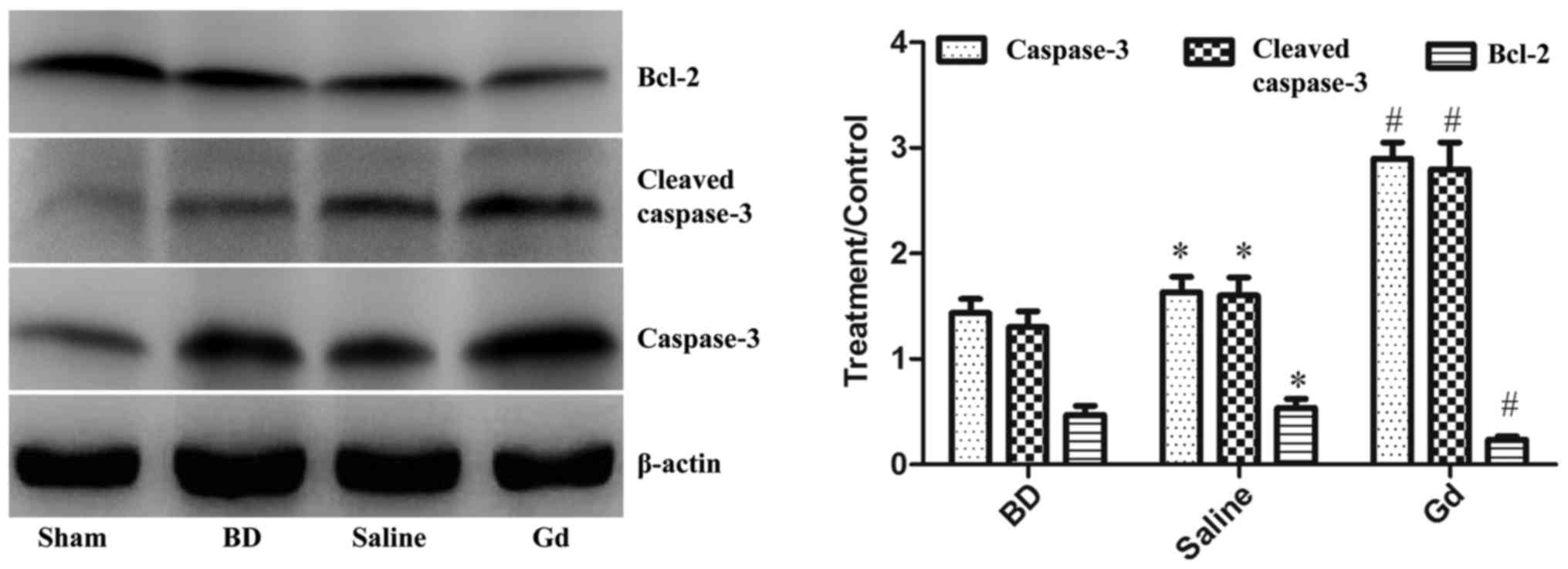|
1
|
Tacke F, Kroy DC, Barreiros AP and Neumann
UP: Liver transplantation in Germany. Liver Transplant.
22:1136–1142. 2016. View
Article : Google Scholar
|
|
2
|
Van der Hoeven JA, Lindell S, van
Schilfgaarde R, Molema G, Ter Horst GJ, Southard JH and Ploeg RJ:
Donor brain death reduces survival after transplantation in rat
livers preserved for 20 hr. Transplantation. 72:1632–1636. 2001.
View Article : Google Scholar : PubMed/NCBI
|
|
3
|
Neuberger J: Liver transplantation in the
United Kingdom. Liver Transpl. 22:1129–1135. 2016. View Article : Google Scholar : PubMed/NCBI
|
|
4
|
Westendorp WH, Leuvenink HG and Ploeg RJ:
Brain death induced renal injury. Curr Opin Organ Transplant.
16:151–156. 2011. View Article : Google Scholar : PubMed/NCBI
|
|
5
|
Pratschke J, Wilhelm MJ, Kusaka M, Basker
M, Cooper DK, Hancock WW and Tilney NL: Brain death and its
influence on donor organ quality and outcome after transplantation.
Transplantation. 67:343–348. 1999. View Article : Google Scholar : PubMed/NCBI
|
|
6
|
Olinga P, van der Hoeven JA, Merema MT,
Freund RL, Ploeg RJ and Groothuis GM: The influence of brain death
on liver function. Liver Int. 25:109–116. 2005. View Article : Google Scholar : PubMed/NCBI
|
|
7
|
Novitzky D, Mi Z, Videla LA, Collins JF
and Cooper DK: Thyroid hormone therapy and procurement of livers
from brain-dead donors. Endocr Res. 41:270–273. 2016. View Article : Google Scholar : PubMed/NCBI
|
|
8
|
Leithead JA, Armstrong MJ, Corbett C,
Andrew M, Kothari C, Gunson BK, Muiesan P and Ferguson JW: Hepatic
ischemia reperfusion injury is associated with acute kidney injury
following donation after brain death liver transplantation. Transpl
Int. 26:1116–1125. 2013. View Article : Google Scholar : PubMed/NCBI
|
|
9
|
Van Der Hoeven JA, Moshage H, Schuurs T,
Nijboer M, Van Schilfgaarde R and Ploeg RJ: Brain death induces
apoptosis in donor liver of the rat. Transplantation. 76:1150–1154.
2003. View Article : Google Scholar : PubMed/NCBI
|
|
10
|
Wen SW, Ager EI, Neo J and Christophi C:
The renin angiotensin system regulates Kupffer cells in colorectal
liver metastases. Cancer Biol Ther. 14:720–727. 2013. View Article : Google Scholar : PubMed/NCBI
|
|
11
|
Tsutsui H and Nishiguchi S: Importance of
Kupffer cells in the development of acute liver injuries in mice.
Int J Mol Sci. 15:7711–7730. 2014. View Article : Google Scholar : PubMed/NCBI
|
|
12
|
Liu C, Yang Z, Wang L, Lu Y, Tang B, Miao
H, Xu Q and Chen X: Combination of sorafenib and gadolinium
chloride (GdCl3) attenuates dimethylnitrosamine(DMN)-induced liver
fibrosis in rats. BMC Gastroenterol. 15:1592015. View Article : Google Scholar : PubMed/NCBI
|
|
13
|
Cao S, Wang T, Yan B, Lu Y, Guo W and
Zhang S: Protective effects of SP600125 in brain death-induced
liver injury. Clin Res Hepatol Gastroenterol. 38:577–582. 2014.
View Article : Google Scholar : PubMed/NCBI
|
|
14
|
Zhang S, Cao S, Wang T, Yan B, Lu Y and
Zhao Y: Modified brain death model for rats. Exp Clin Transplant.
12:469–473. 2014.PubMed/NCBI
|
|
15
|
Pratschke J, Wilhelm MJ, Kusaka M,
Laskowski I and Tilney NL: A model of gradual onset brain death for
transplant-associated studies in rats. Transplantation. 69:427–430.
2000. View Article : Google Scholar : PubMed/NCBI
|
|
16
|
Knodell RG, Ishak KG, Black WC, Chen TS,
Craig R, Kaplowitz N, Kiernan TW and Wollman J: Formulation and
application of a numerical scoring system for assessing
histological activity in asymptomatic chronic active hepatitis.
Hepatology. 1:431–435. 1981. View Article : Google Scholar : PubMed/NCBI
|
|
17
|
Desmet VJ: Knodell RG, Ishak KG, Black WC,
Chen TS, Craig R, Kaplowitz N, Kiernan TW, Wollman J. Formulation
and application of a numerical scoring system for assessing
histological activity in asymptomatic chronic active hepatitis
[Hepatology 1981;1:431-435]. J Hepatol. 38:382–386. 2003.
View Article : Google Scholar : PubMed/NCBI
|
|
18
|
Wu Y, Wang Y, Li M, Yang X, Gong J and
Zhang W: Gadolinium chloride suppresses acute rejection and induces
tolerance following rat liver transplantation by inhibiting
Kupffer-cell activation. Exp Ther Med. 8:1777–1782. 2014.
View Article : Google Scholar : PubMed/NCBI
|
|
19
|
Ellett JD, Atkinson C, Evans ZP, Amani Z,
Balish E, Schmidt MG, van Rooijen N, Schnellmann RG and Chavin KD:
Murine Kupffer cells are protective in total hepatic
ischemia/reperfusion injury with bowel congestion through IL-10. J
Immunol. 184:5849–5858. 2010. View Article : Google Scholar : PubMed/NCBI
|
|
20
|
Barklin A: Systemic inflammation in the
brain-dead organ donor. Acta Anaesthesiol Scand. 53:425–435. 2009.
View Article : Google Scholar : PubMed/NCBI
|
|
21
|
Weiss S, Kotsch K, Francuski M,
Reutzel-Selke A, Mantouvalou L, Klemz R, Kuecuek O, Jonas S,
Wesslau C, Ulrich F, et al: Brain death activates donor organs and
is associated with a worse I/R injury after liver transplantation.
Am J Transplant. 7:1584–1593. 2007. View Article : Google Scholar : PubMed/NCBI
|
|
22
|
Kotsch K, Ulrich F, Reutzel-Selke A,
Pascher A, Faber W, Warnick P, Hoffman S, Francuski M, Kunert C,
Kuecuek O, et al: Methylprednisolone therapy in deceased donors
reduces inflammation in the donor liver and improves outcome after
liver transplantation: A prospective randomized controlled trial.
Ann Surg. 248:1042–1050. 2008. View Article : Google Scholar : PubMed/NCBI
|
|
23
|
Zhu C, Li J, Zhang G, Zhang Y, Zhai W, Shi
J, Li Z, Li J and Zhang S: Brain death disrupts structure and
function of pig liver. Transplant Proc. 42:pp. 733–736. 2010;
View Article : Google Scholar : PubMed/NCBI
|
|
24
|
Kuecuek O, Mantouvalou L, Klemz R, Kotsch
K, Volk HD, Jonas S, Wesslau C, Tullius S, Neuhaus P and Pratschke
J: Significant reduction of proinflammatory cytokines by treatment
of the brain-dead donor. Transplant Proc. 37:pp. 387–388. 2005;
View Article : Google Scholar : PubMed/NCBI
|
|
25
|
Li JQ, Qi HZ, He ZJ, Hu W, Si ZZ, Li YN
and Li DB: Cytoprotective effects of human interleukin-10 gene
transfer against necrosis and apoptosis induced by hepatic cold
ischemia/reperfusion injury. J Surg Res. 157:e71–e78. 2009.
View Article : Google Scholar : PubMed/NCBI
|
|
26
|
Olinga P, Merema MT, de Jager MH, Derks F,
Melgert BN, Moshage H, Slooff MJ, Meijer DK, Poelstra K and
Groothuis GM: Rat liver slices as a tool to study LPS-induced
inflammatory response in the liver. J Hepatol. 35:187–194. 2001.
View Article : Google Scholar : PubMed/NCBI
|
|
27
|
Cao S, Wang T, Yan B, Lu Y, Zhao Y and
Zhang S: Brain death is associated with endoplasmic reticulum
stress and apoptosis in rat liver. Transplant Proc. 46:pp.
3297–3302. 2014; View Article : Google Scholar : PubMed/NCBI
|
|
28
|
Baskin-Bey ES, Washburn K, Feng S,
Oltersdorf T, Shapiro D, Huyghe M, Burgart L, Garrity-Park M, van
Vilsteren FG, Oliver LK, et al: Clinical trial of the pan-caspase
inhibitor, IDN-6556, in human liver preservation injury. Am J
Transplant. 7:218–225. 2007. View Article : Google Scholar : PubMed/NCBI
|
|
29
|
Sutter AG, Palanisamy AP, Ellet JD,
Schmidt MG, Schnellmann RG and Chavin KD: Intereukin-10 and Kupffer
cells protect steatotic mice livers from ischemia-reperfusion
injury. Eur Cytokine Netw. 25:69–76. 2014.PubMed/NCBI
|
|
30
|
Wan J, Benkdane M, Teixeira-Clerc F,
Bonnafous S, Louvet A, Lafdil F, Pecker F, Tran A, Gual P, Mallat
A, et al: M2 Kupffer cells promote M1 Kupffer cell apoptosis: A
protective mechanism against alcoholic and nonalcoholic fatty liver
disease. Hepatology. 59:130–142. 2014. View Article : Google Scholar : PubMed/NCBI
|
|
31
|
Wang B, Zhang Q, Zhu B, Cui Z and Zhou J:
Protective effect of gadolinium chloride on early warm
ischemia/reperfusion injury in rat bile duct during liver
transplantation. PLoS One. 8:e527432013. View Article : Google Scholar : PubMed/NCBI
|
|
32
|
Golling M, Mehrabi A, Blum K, Jahnke C,
Kellner H, Bud O, Hashemi B, Breitkreutz R, Becker-Brandenburg K,
Schemmer P, et al: Effects of hemodynamic instability on brain
death-induced prepreservation liver damage. Transplantation.
75:1154–1159. 2003. View Article : Google Scholar : PubMed/NCBI
|
|
33
|
Ritschl PV, Ashraf MI, Oberhuber R,
Mellitzer V, Fabritius C, Resch T, Ebner S, Sauter M, Klingel K,
Pratschke J and Kotsch K: Donor brain death leads to differential
immune activation in solid organs but does not accelerate
ischaemia-reperfusion injury. J Pathol. 239:84–96. 2016. View Article : Google Scholar : PubMed/NCBI
|













